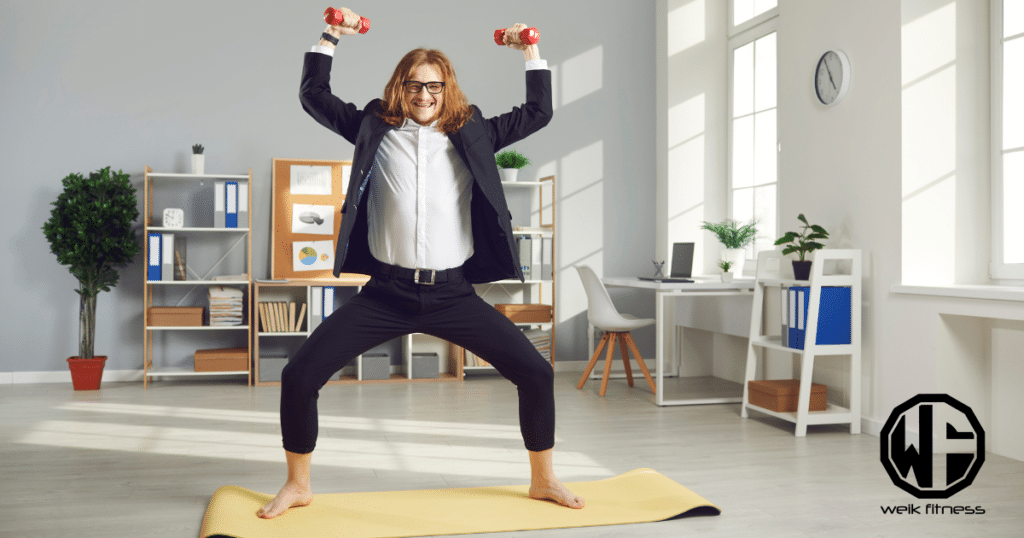Office Fitness: Walk This Way… Talk This Way
How many of us have desk jobs? Probably a good percentage, right? How many of you feel as though getting up during the day to take a walk would get you called into the boss’s office? Many people feel that way and it’s a problem in today’s workforce. Most people are not taking the time to get up and move throughout the day (office fitness) and it’s causing many American’s the need to go out and buy bigger pants.
Disclaimer: This article is for informational purposes only and is not meant to treat or diagnose any condition. It is recommended that you speak with your doctor before engaging in any exercise program.
How Could Sitting in Your Office All Day Cause Health Issues?

Sitting in your office all day can lead to a variety of health issues, both short-term and long-term. Here are some ways in which prolonged sitting can negatively impact your health:
- Increased Risk of Chronic Diseases:
- Obesity: Sitting for extended periods reduces calorie expenditure, which can lead to weight gain and obesity.
- Type 2 Diabetes: A sedentary lifestyle can contribute to insulin resistance and an increased risk of developing type 2 diabetes.
- Heart Disease: Prolonged sitting is associated with higher levels of triglycerides and lower levels of HDL (good) cholesterol, which can increase the risk of heart disease.
- Muscle and Joint Problems:
- Muscle Atrophy: Sitting for long periods can lead to muscle weakness and atrophy, particularly in the legs and core muscles.
- Back Pain: Poor posture while sitting can strain the back, leading to chronic back pain.
- Neck and Shoulder Pain: Hunching over a computer or phone can cause neck and shoulder pain and stiffness.
- Poor Circulation:
- Sitting for extended periods can slow blood circulation, increasing the risk of blood clots and deep vein thrombosis (DVT).
- It can also lead to swollen ankles and feet.
- Mental Health Issues:
- Prolonged sitting can contribute to stress, anxiety, and depression.
- Lack of physical activity can lead to reduced production of endorphins, which are mood-enhancing hormones.
- Metabolic Problems:
- Prolonged sitting can disrupt metabolic processes, leading to increased insulin resistance and a higher risk of metabolic syndrome.
- Reduced Productivity:
- While not a direct health issue, sitting for long periods can reduce productivity and focus due to discomfort and decreased circulation to the brain.
- Eye Strain:
- Staring at a computer screen for hours can lead to digital eye strain, which can cause headaches, dry eyes, and blurred vision.
- Increased Risk of Certain Cancers:
- Some studies suggest that prolonged sitting is associated with an increased risk of certain types of cancer, including colon, breast, and ovarian cancer.
To mitigate these health risks, it’s important to incorporate regular breaks, standing or walking periods, and ergonomic adjustments into your work routine. Consider using a standing desk, taking short walks during breaks, and practicing good posture to minimize the negative effects of prolonged sitting. Regular exercise outside of work hours is also crucial for maintaining overall health and well-being.
What Can You Do In Your Office as “Office Fitness” to Stay Fit and Healthy?

Staying fit and healthy while working in an office environment is essential to counteract the negative effects of prolonged sitting and a sedentary lifestyle. Here are some strategies and activities you can incorporate into your office routine to promote your well-being:
- Use a Standing Desk:
- If possible, invest in a standing desk or a desk converter that allows you to switch between sitting and standing positions throughout the day.
- Alternate between sitting and standing to reduce the strain on your back and improve circulation.
- Take Regular Breaks:
- Set reminders to take short breaks every hour. Use these breaks to stand up, stretch, and walk around your office or workspace.
- Perform simple stretches to relieve muscle tension, especially in your neck, shoulders, and back.
- Stay Hydrated:
- Keep a water bottle at your desk and make an effort to stay hydrated throughout the day. Proper hydration is important for overall health and energy levels.
- Practice Good Ergonomics:
- Adjust your chair, keyboard, and monitor to ensure proper ergonomics. Your computer monitor should be at eye level, and your keyboard and mouse should be at a comfortable height.
- Sit with your feet flat on the floor, and maintain a neutral spine position.
- Incorporate Desk Exercises:
- Try desk exercises such as chair squats, leg lifts, or seated leg circles to engage your muscles while sitting.
- Do seated stretches to improve flexibility and reduce tension.
- Use Resistance Bands:
- Keep resistance bands at your desk and use them for short workouts or stretches during breaks.
- Resistance bands can be used for various exercises to work different muscle groups.
- Promote Active Commuting:
- If possible, consider walking or cycling to work, or using public transportation that involves some walking.
- If you drive, park farther away from the office to incorporate more walking into your daily routine.
- Healthy Snacking:
- Choose nutritious snacks like fruits, vegetables, nuts, and yogurt over sugary or processed options.
- Avoid excessive caffeine and sugar intake.
- Stay Mindful of Posture:
- Be conscious of your posture while sitting and standing. Keep your shoulders relaxed, back straight, and neck in a neutral position.
- Consider using ergonomic accessories like lumbar cushions to support your lower back.
- Encourage Physical Activity:
- Organize office fitness challenges or activities, such as group walks during lunch breaks or yoga sessions.
- Take the stairs instead of the elevator when possible.
- Prioritize Mental Health:
- Practice stress-relief techniques like deep breathing or mindfulness meditation to manage work-related stress.
- Decorate your workspace with calming elements or personal items that make you feel comfortable.
- Plan Your Meals:
- Bring homemade, balanced meals to work, or choose healthy options from nearby restaurants.
- Avoid excessive consumption of processed or fast food.
Remember that consistency is key. Incorporate these practices into your daily routine, and encourage your colleagues to do the same. By making small changes and prioritizing your health in the office, you can improve your overall well-being and productivity.
Office Fitness 101
A new study could possibly help employers promote health with one simple change—engaging in some office fitness which could be one “walking meeting” per week. What? I know, I read your mind….. office fitness? And it’s exactly what you are envisioning. A new study conducted by the University of Miami, Miller School of Medicine has shown that there are several health benefits from office fitness and having a meeting where all participants are walking together versus sitting in a meeting or conference room.

The American Heart Association recommends that everyone should get at least 150 minutes of physical activity each week (that breaks down to 5 days of physical activity for 30 minutes each day during the week). When you think about it, giving up 30 minutes of your day really isn’t that much. In a 24-hour period, we’re talking about roughly 2% of your time. Still can’t seem to find 30 minutes to get active? I bet if you turned off the television at night you’d be able to find the time pretty easily.
A professor at the University said, “Physical activity interventions such as the walking meeting protocol that encourages walking and raises levels of physical activity in the workplace are needed to counter the negative health effects of sedentary behavior.”
White-collar workers from the University of Miami were used as the participants for this study. Each participant wore an accelerometer every workday (Monday through Friday) for three weeks to measure their overall physical activity levels while at work and conducting office fitness. During this timeframe, each participant was engaged in “walking meetings.” What the researchers found was that as the weeks went by, the participant’s activity level increased.
Click here to continue reading…


*Disclosure: This article may contain affiliate links or ads, which means we earn a small commission at no extra cost to you if you make a purchase through these links. These commissions help support the operation and maintenance of our website, allowing us to continue producing free valuable content. Your support is genuinely appreciated, whether you choose to use our links or not. Thank you for being a part of our community and enjoying our content.
PLEASE CONSIDER SHARING THIS ON YOUR SOCIAL MEDIA TO HELP OTHERS LEARN MORE ABOUT THIS TOPIC.





